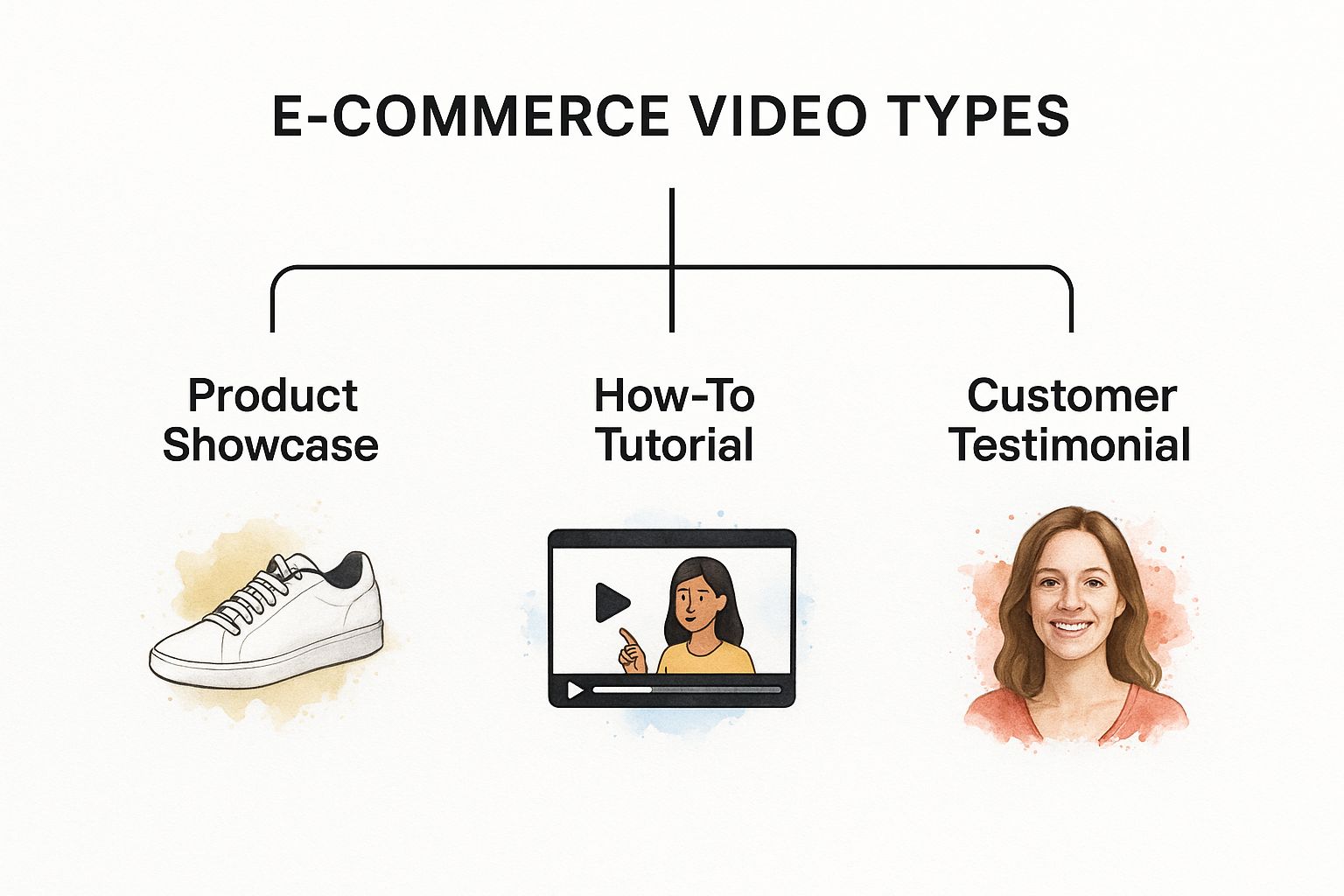At its heart, an e-commerce video is any video you use on your online store—or in your marketing—to show off products, earn a customer's trust, and ultimately, drive sales. Think of it as your best digital salesperson, one who can demonstrate every feature and benefit to customers who can't physically touch or see your products.
Why E-commerce Video Is a Sales Superpower

Picture a virtual sales assistant working tirelessly on your product pages, 24/7. This isn't just someone listing off features; they're demonstrating them in real-time, answering questions before they're even asked, and building a genuine sense of confidence in potential buyers. That's exactly what a good e-commerce video does. It closes the massive gap between just browsing online and the hands-on experience of shopping in a real store.
In a brick-and-mortar shop, a customer can pick up a product, feel its weight, and check the quality up close. Online, they're stuck with static photos and text descriptions, which almost always leaves a little room for doubt. Video smashes through that uncertainty by showing your product in motion and in context, making the whole digital experience feel more tangible and trustworthy.
Building Trust and Driving Action
This knack for building confidence isn't just a nice-to-have feature; it's a direct line to more revenue. When a shopper sees a video of a jacket holding up in a downpour or a blender turning a block of ice into snow, their hesitation starts to fade. They can actually picture the product in their own life, which is a massive psychological nudge toward making a purchase.
The numbers back this up, big time. Recent stats show that 89% of businesses are now using video as a core marketing tool—a huge testament to its power. Even more telling, 93% of marketers say they get a positive Return on Investment (ROI) from their videos, and 95% see it as an absolutely critical piece of their overall strategy.
Video marketing isn't just about showing off what you sell. It's about transferring confidence from your brand to your customer, making that "Add to Cart" button feel like the most logical, easy next step.
More Than Just a Marketing Trend
When it comes down to it, having an e-commerce video strategy is about more than just staying current. It represents a fundamental shift in how brands connect with their audiences. By demonstrating real value, showing authenticity, and answering questions visually, you transform passive window-shoppers into confident, ready-to-buy customers.
This is especially true when you let real customers do the talking. To see just how powerful this is, explore the power of video testimonials for business, which builds undeniable social proof and gives sales a direct boost. This kind of authentic content tackles customer skepticism head-on, proving your product really does what you say it does. When you invest in video, you're not just buying equipment; you're investing in a stronger, more profitable relationship with your customers.
Choosing the Right Video for Your Product
Picking the right e-commerce video is a lot like choosing the right tool for a specific job. You wouldn't bring a sledgehammer to hang a picture frame, right? In the same way, the video format you choose needs to match your product and, just as importantly, your marketing goal—whether that's building trust, explaining a tricky feature, or just getting people excited.
Every video format connects with customers on a different level. A detailed product demo, for instance, can be a game-changer for a technical gadget. On the other hand, a heartfelt customer testimonial might be the only thing that convinces someone to buy a high-end wellness product. Getting a handle on these nuances is the first step to building a video strategy that actually works.
The Core E Commerce Video Formats
Let’s break down the most effective video types you’ll come across. Think of these as the foundation of your entire video marketing plan. Each one is built to address a specific customer doubt or question, helping to gently guide them toward making a confident purchase.
- Product Demo Videos: These are your virtual "try before you buy" experiences. They put your product in the spotlight, showing off its features and benefits in a real-world setting. Watching a non-stick pan fry an egg without a drop of oil is a whole lot more persuasive than just reading about its special coating.
- Explainer Videos: Does your product solve a complex problem? Or maybe it has some brilliant features that aren't immediately obvious. That’s where an explainer video comes in. These videos zero in on the "how" and "why," making the value crystal clear and heading off any potential customer confusion before it starts.
- Testimonial Videos: Nothing builds trust faster than good old-fashioned social proof. Testimonial videos let your real, happy customers do the selling for you. Hearing an authentic story from someone just like them is often the final nudge a hesitant shopper needs to click "buy."
This diagram gives a great overview of how these primary video categories function.

As you can see, showing the product, explaining how it works, and using customer feedback are all distinct but equally vital strategies.
To help you decide which video to use and where, here's a quick comparison of the most common formats.
Comparing E Commerce Video Formats and Their Impact
This table breaks down the primary purpose, key benefits, and ideal placement for the most effective types of e-commerce videos.
| Video Type | Primary Goal | Key Benefit | Best Placement |
|---|---|---|---|
| Product Demo | Showcase features and functionality | Builds product confidence, answers "how-to" questions | Product pages, social media ads, landing pages |
| Explainer Video | Clarify a complex value proposition | Educates the customer, reduces confusion and returns | Homepage, product pages, email campaigns |
| Testimonial | Build trust and social proof | Creates authenticity, overcomes purchase hesitation | Product pages, checkout page, retargeting ads |
| Unboxing | Create excitement and authenticity | Provides an unfiltered first impression, builds anticipation | Social media (especially YouTube/Instagram), influencer collaborations |
Each format plays a unique role in the customer journey, from grabbing initial attention to sealing the deal.
Matching the Video to Your Goal
Now, let's tie these formats to real-world outcomes. Your choice has to be intentional. Are you trying to cut down on returns by setting clear expectations? Or is your goal to stop someone mid-scroll on Instagram?
For example, a product demo is a must-have for your product page, where shoppers are actively weighing their options. It answers those final, lingering questions and shows the product in its best light. Considering viewers retain 95% of information from a video compared to just 10% from text, demos are incredibly powerful at this make-or-break stage.
Unboxing Videos are another powerhouse format. They tap into the genuine thrill of getting something new in the mail, offering an authentic, unfiltered peek at your product and packaging that builds both trust and excitement.
When it comes to paid advertising, formats like Video Sales Letter (VSL) ads are structured specifically for direct-response campaigns designed to drive immediate sales.
Ultimately, a winning e-commerce video strategy isn't about picking just one format. It's about using a smart mix. You can learn more about crafting a cohesive plan in our complete guide to video marketing for ecommerce. By deploying different videos at the right moments, you create a complete experience that guides customers all the way from "What's this?" to "I need this!"
How Video Turns Window Shoppers Into Paying Customers
Think about the biggest hurdle in e-commerce. It's not price or selection; it's the fact that customers can't physically touch or hold what they're buying. That tiny seed of doubt—"What if it's not the right size? What if the color is off?"—is the number one killer of conversions and a primary cause of abandoned carts.
An e-commerce video doesn't just show a product. It bridges that gap. It acts as a virtual, in-hand demonstration that gives browsers the confidence they need to click "buy." Video turns a potential gamble into a well-informed decision.
Building Real Trust Through Transparency
When a video shows a product from every angle, in a real-world setting, it sets honest expectations. A simple video can finally answer nagging questions: What's the actual size of that handbag? What does that lipstick shade really look like in natural light? Just how tough is that backpack's fabric?
This level of transparency is priceless. It's why adding video has such a massive impact. For starters, well-made explainer videos can slash product returns by as much as 35%—because buyers know exactly what’s coming.
And the on-page impact? Product pages with video see a 47% higher engagement rate, and a staggering 64% of consumers are more likely to buy after watching one.
Keeping People Engaged Means More Sales
Beyond building trust, video is incredibly effective at one simple thing: keeping people on your page longer. The more time someone spends with your product, the more invested they become in it and your brand. Static images and a block of text can be scanned and dismissed in seconds. A good video, however, grabs attention and holds it.
A shopper who is engaged is a shopper who is one step closer to making a purchase. By keeping them on your page, video dramatically increases the probability of a conversion by replacing passive browsing with active consideration.
Imagine someone lands on a product page for a new coffee maker. A few polished photos show what it looks like. But a quick, 60-second video shows them how simple it is to set up, how fast it brews, and the beautiful crema it produces.
That short, engaging story just transformed a static object into a desirable morning ritual. Suddenly, that "Add to Cart" button isn't just an option; it's the next logical step.
Ready to dive deeper into the tactics that turn those views into real revenue? Our guide reveals powerful e-commerce video marketing secrets that drive real sales.
Creating Product Videos That Actually Convert

Let's get one thing straight: you don't need a Hollywood budget to create an e-commerce video that drives sales. The videos that actually work aren't always the most expensive. They’re the ones built on a few core principles that respect the viewer's time and attention. Success is all about strategy, not just fancy gear.
The real key is understanding how people watch videos today—quickly, and almost always on their phones. Your goal is simple: create something that stops the scroll, delivers value in an instant, and makes the path to purchase feel like a no-brainer.
Let's break down the practical elements that turn a simple product video into a real conversion machine.
The First Three Seconds Are Everything
In the fast-flowing river of social media feeds, you have a tiny window to grab someone's attention. Your video's first three seconds have to land a compelling hook. This is no time for a slow, cinematic logo reveal. Get straight to the action.
Show the product in an interesting context. Present a common problem it solves. Use a visually striking shot. Think of it as your video's headline—if it isn’t strong enough, people will just keep scrolling.
Mobile-First and Vertical-Ready
The overwhelming majority of your audience will see your video on a mobile device. This means optimizing for a vertical screen isn't just a nice-to-have; it's non-negotiable.
While only 30% of viewers will bother turning their phone sideways to watch a video, even fewer will stick around to finish it.
By designing your e-commerce video for vertical screens (like a 9:16 aspect ratio), you make sure it fills the entire screen. This creates a more immersive experience that feels native to platforms like Instagram, TikTok, and YouTube Shorts.
This also means any text or visuals need to be big and clear enough to be understood on a small screen, often without any sound at all.
Audio Quality Is Non-Negotiable
It's true that many people watch videos with the sound off, but for those who do listen, pristine audio is critical. Bad sound—whether it’s background noise, an echo, or a muffled voice—can make your brand feel unprofessional and untrustworthy in a heartbeat.
Invest in a simple, affordable microphone. It’s a small cost for a huge gain. Clear audio makes your narration and product sounds more impactful, ensuring your message is heard loud and clear—especially for how-to videos and testimonials.
For a deeper dive into the technical side of production, check out our complete guide to driving sales and engagement with product videos.
Essential Elements of a High-Converting Video
To make sure your video actually performs, focus on these key components:
- Optimal Length: Keep it short and sweet. For social media, try to stay under 60 seconds. For product pages, 30-90 seconds is usually the sweet spot to show value without losing attention.
- Clear Call-to-Action (CTA): Tell your viewers exactly what to do next. Whether it's "Shop Now," "Learn More," or "Swipe Up," your CTA needs to be visually prominent and stated clearly.
- Engaging Captions: Since a staggering 81% of viewers mute video ads, your on-screen captions are doing the heavy lifting. Use them to hit your key points and drive the message home.
Where to Place Your Videos for Maximum Impact
Creating a brilliant e-commerce video is a huge win, but it’s only half the job. A fantastic video without a proper stage is like a silent movie—all the potential is there, but the impact gets lost. To see real results, you have to strategically place your content right where your customers are, at every step of their journey.
This means looking past the obvious spots, like your product pages, and building out a full distribution plan. Your video strategy shouldn't be confined to a single location. It should be a connected ecosystem that engages shoppers from the moment they discover you to the final click to buy. Each placement needs a purpose, tied directly to a business goal.
Key Video Placement Channels
Your main objective is to create a seamless experience where video naturally supports a customer's decision to buy. Think of it less like an ad and more like helpful, visual guidance delivered at the perfect time.
Here are the most critical places to feature your e-commerce videos:
- Product Pages: This is non-negotiable. A video here is your final, most powerful sales pitch. It answers last-minute questions and builds the confidence someone needs to hit "Add to Cart." It’s your best shot at showing the product in action, which can boost conversions significantly.
- High-Traffic Landing Pages: Your homepage and key landing pages are prime real estate. A well-placed video can increase organic traffic by as much as 157% by instantly grabbing attention and communicating your brand's core value.
- Social Media Platforms: Channels like Instagram, TikTok, and YouTube are built for top-of-funnel awareness. Use short, snappy clips to stop the scroll, drive people back to your site, and start building a community around your brand.
- Email Marketing Campaigns: Dropping a video (or just a thumbnail that links to one) into your emails is a surefire way to lift your click-through rates. They work wonders in welcome sequences, abandoned cart reminders, and promotional newsletters to pull your audience back in.
Extending Your Reach
Just posting on your own channels is a start, but you also need to think about amplification. Getting your video onto other relevant platforms can introduce your brand to completely new audiences who are already in a buying mindset.
A great e-commerce video has a ripple effect. Its value grows exponentially when it’s seen not just on your website, but across multiple platforms where your target customers spend their time.
One of the best ways to do this is by implementing content syndication best practices. This involves strategically republishing your video on third-party sites, blogs, or marketplaces. You effectively multiply your visibility and drive qualified traffic back to your store without having to create anything new.
Measuring the ROI of Your Video Strategy
 So, you've created a fantastic e-commerce video. That's a great start, but how do you actually prove it’s making you money? Seeing a real return on your investment means looking past feel-good numbers like total views. A high view count is nice, but it doesn’t tell you if anyone stuck around long enough to care or, more importantly, take action.
So, you've created a fantastic e-commerce video. That's a great start, but how do you actually prove it’s making you money? Seeing a real return on your investment means looking past feel-good numbers like total views. A high view count is nice, but it doesn’t tell you if anyone stuck around long enough to care or, more importantly, take action.
You need to focus on metrics that show a real business impact. Think of it like a performance review for your video content—you want to know if it's hitting its sales targets, not just showing up to work. This means digging into the data to see how people are really interacting with what you've created.
Key Metrics That Actually Matter
To get a clear picture of your video’s performance, you need to track specific Key Performance Indicators (KPIs) that connect directly to your business goals. These are the numbers that tell the real story of how your e-commerce video is influencing customer behavior.
Here are the essential metrics you should be watching:
- Play Rate: This is the percentage of visitors who actually clicked the play button. A low play rate might signal that your thumbnail image isn't compelling enough or that the video's placement on the page is off.
- Audience Retention: This graph shows you the exact moment viewers start to drop off. If most people bail in the first few seconds, your opening hook needs some serious work. If there's a big dip at a specific point, you know which part of your message isn't landing.
- Click-Through Rate (CTR): This measures how many viewers clicked your call-to-action (CTA), like a "Shop Now" button. It’s a direct indicator of how persuasive your video is.
- Conversion Rate: This is the big one. It tracks how many viewers went on to make a purchase after watching. Connecting video views to actual sales is the clearest, most undeniable way to prove ROI.
A video’s success isn’t just about how many people see it, but how many people it successfully moves to the next step. Focus on engagement and conversion to understand your true ROI.
By analyzing this data from platforms like YouTube, your e-commerce host, and your social media channels, you can gather genuinely useful insights. This data-driven approach lets you fine-tune your strategy, understand what your audience truly wants, and make much smarter decisions for every single e-commerce video you create from here on out.
E-Commerce Video FAQ
Jumping into e-commerce video can feel like opening a can of worms—lots of questions pop up. Let's tackle some of the most common ones brands ask. We'll cut through the noise and give you some straightforward, practical advice to get you rolling with confidence.
How Long Should My E-Commerce Video Be?
There's no single magic number. The best video length really hinges on where you're putting it and what you want it to do.
On your product pages, you’re in the sweet spot between 30-90 seconds. That's usually enough time to hit the highlights and show the product in action without your customer’s attention wandering. For the blink-and-you'll-miss-it world of social media, like Instagram Reels or TikTok, you absolutely have to keep it under 60 seconds to stop the scroll.
Now, if you're creating a more in-depth explainer or a detailed how-to video, stretching to 2-3 minutes is perfectly fine, as long as the content is genuinely useful and keeps people hooked.
Do I Need Expensive Video Equipment?
Absolutely not. You can get fantastic results with a modern smartphone. Seriously. It’s far more important to nail the fundamentals than it is to splurge on fancy gear.
The most critical elements for a professional-looking e-commerce video are good lighting (natural light from a window is perfect), a simple tripod to keep the shot steady, and a clear microphone for crisp audio.
Focus on those three things, and you'll be miles ahead of people with expensive cameras but poor lighting and shaky footage.
Where Should I Place My First Video?
Your product detail page. Without a doubt, this is the most critical spot for your first e-commerce video.
Think about it—this is where your customer is making their final call. A video at this stage can be the final nudge of confidence they need to click "Add to Cart."
Once you've got that covered, your next priorities should be slicing up that video into clips for your most active social media channels and dropping it into key email marketing campaigns. It's a great way to drive traffic back to your site and re-engage your audience.